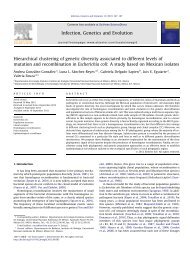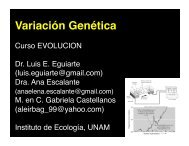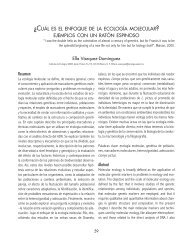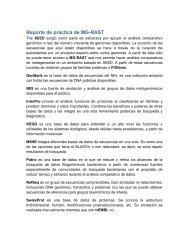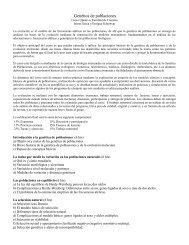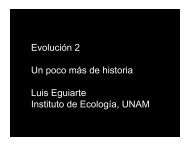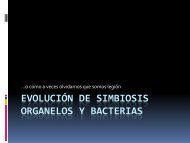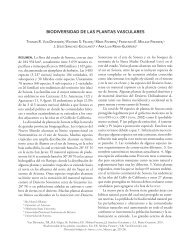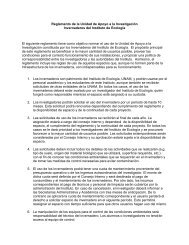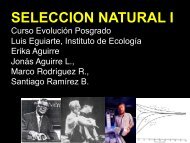4VariacionEvolucion2b copy.pdf - Instituto de Ecología
4VariacionEvolucion2b copy.pdf - Instituto de Ecología
4VariacionEvolucion2b copy.pdf - Instituto de Ecología
- No tags were found...
You also want an ePaper? Increase the reach of your titles
YUMPU automatically turns print PDFs into web optimized ePapers that Google loves.
Molecular Ecology (2010) 19, 1162–1173doi: 10.1111/j.1365-294X.2010.04559.xFine scale genetic structure in the wild ancestor of maize(Zea mays ssp. parviglumis)JOOST VAN HEERWAARDEN,* JEFFREY ROSS-IBARRA,* JOHN DOEBLEY,†JEFFREY C. GLAUBITZ,† JOSE DE JESÚSSÁNCHEZ GONZÁLEZ,‡ BRANDON S. GAUT§and LUIS E. EGUIARTE–*Department of Plant Sciences, University of California, Davis, CA 95616, USA, †Department of Genetics, University ofWisconsin, Madison, WI 53706, USA, ‡Centro Universitario <strong>de</strong> Ciencias Biológicas y Agropecuarias, Universidad <strong>de</strong>Guadalajara, Zapopan, Jalisco CP45110, Mexico, §Department of Ecology and Evolutionary Biology, University of California,Irvine, CA 92697, USA, –Departamento <strong>de</strong> <strong>Ecología</strong> Evolutiva, <strong>Instituto</strong> <strong>de</strong> <strong>Ecología</strong>, Universidad Nacional Autónoma <strong>de</strong>México, CU, AP 70-275 Coyoacán, 04510 México, DF, México955 individuals genotyped for 468 SNPs.!AbstractAnalysis of fine scale genetic structure in continuous populations of outcrossing plantspecies has traditionally been limited by the availability of sufficient markers. We used aset of 468 SNPs to characterize fine-scale genetic structure within and between two <strong>de</strong>nsestands of the wild ancestor of maize, teosinte (Zea mays ssp. parviglumis). Our analysesconfirmed that teosinte is highly outcrossing and showed little population structure overshort distances. We found that the two populations were clearly genetically differentiated,although the actual level of differentiation was low. Spatial autocorrelation ofrelatedness was observed within both sites but was somewhat stronger in one of thepopulations. Using principal component analysis, we found evi<strong>de</strong>nce for significantlocal differentiation in the population with stronger spatial autocorrelation. Thisdifferentiation was associated with pronounced shifts in the first two principalcomponents along the field. These shifts correspon<strong>de</strong>d to changes in allele frequencies,



